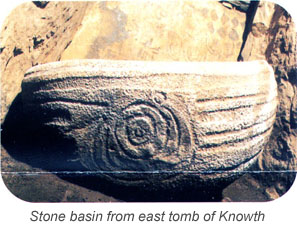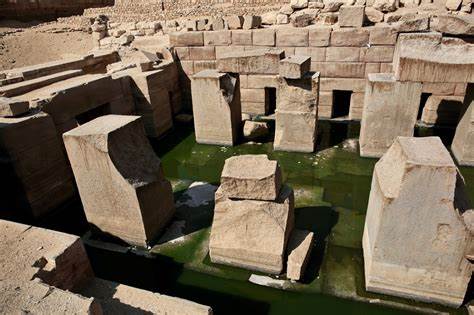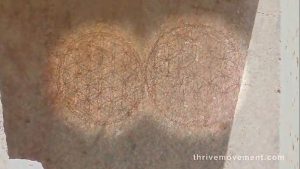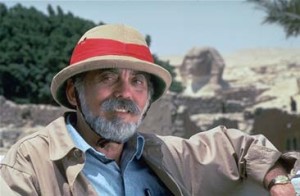Osirion
Newgrange *
Newgrange is a Neolithic monument in Ireland’s Boyne Valley, County Meath. It was constructed around 3,200 BC, which makes it older than Stonehenge and the Pyramids of Giza. Newgrange is a large circular mound 85m (279ft) in diameter and 13m (43ft) high with a 19m (63ft) stone passageway and chambers inside. The mound is ringed by 97 large kerbstones, some of which are engraved with megalithic art.
Newgrange was built by a farming community that prospered on the rich lands of the Boyne Valley. Nearby are Knowth and Dowth which are similar mounds that together with Newgrange have been designated a World Heritage Site by UNESCO(a).
 The site was fully investigated and reconstructed between 1962 and 1975. However, the reconstruction was not accepted without criticism(h).
The site was fully investigated and reconstructed between 1962 and 1975. However, the reconstruction was not accepted without criticism(h).
Both Robert Hensey(f), who has studied and written about Newgrange [1766.6] and Mike Parker Pearson, Stonehenge’s leading authority, have endorsed the idea of a French origin for megalith building(g).
Bob Quinn visited the enormous stone circle at Mzora in Morocco and was struck by its similarity to Newgrange(e)!
Newgrange is best known for the illumination of its passage and chamber by the winter solstice sun. Above the entrance to the passage at Newgrange, there is an opening called a roof-box. This baffling orifice held a great surprise for those who unearthed it. Its purpose is to allow sunlight to penetrate the chamber on the shortest days of the year, around December 21st, the winter solstice.
Like all ancient monuments, the Boyne Valley cluster has generated its collection of wild speculation, such as Freddy Silva’s claim that there is a connection between Knowth and Sacsayhuaman near Cuzco in Peru and who also hints at a possible link with Egypt’s Osirion(b)!
The unaccredited Keystone University in Ireland published a video in 2020 in which it claimed that “the neolithic tomb at Newgrange in the Boyne Valley is, in fact, the famed temple of Atlantis and one of the oldest temples on earth as a result(i).” This daft claim is a development of Ulf Erlingsson‘s theories published in 2004.
The winter solstice event is not the only astronomical link proposed for Newgrange. Anthony Murphy and Richard Moore have written(c) about the Cygnus Constellation and a possible link with Newgrange [1441]. Paul Dunbavin also touched on the possible connection between swans in Irish mythology and astronomical events(d).
Even more unlikely is the suggestion from E. A. James Swagger in The Newgrange Sirius Mystery [1683] in which the author endeavoured to link Ireland’s most important megalithic site with both an early understanding of precession and the symbology of the Dogon.
Furthermore, the imaginative Frank Joseph has speculated that “the early date for Newgrange, its circular construction, sophisticated solar orientation and mythic tradition all point to Atlantean origins.” [0636.70]
A common feature of most of the great megalithic monuments, such as Stonehenge, The Maltese Temples or Newgrange is the incorporation of astronomical alignments into their design. Recent years have seen the development of archaeoacoustics and the study of the sound characteristics of various ancient structures. Arguably the most famous site is the Hal Saflieni Hypogeum in Malta, about which Linda Eneix has written an interesting paper(j). She notes that there is a suggestion that sounds there, and possibly elsewhere, might lead to a release of the ‘feel-good’ hormone dopamine. Any inference that this was a deliberate design feature will require evidence. Eneix just touches on Newgrange acoustics that are discussed elsewhere(k).
(a) https://www.knowth.com/newgrange.htm
(c) https://www.third-millennium.co.uk/irishgodkings
(d) Mythical Ireland | Astronomy | The Cygnus Enigma (archive.org)
(e) http://heritageaction.wordpress.com/2011/01/27/the-mysterious-moroccan-megalithic-menhirs-of-mzora/ (see last comment)
(h) https://www.knowth.com/excavation.htm
(i) The Lost City of Atlantis is Ireland (irishcentral.com)
(j) https://www.academia.edu/63669239/Megaliths_Music_and_the_Mind_The_Latest_in_Archaeoacoustics
Cygnus Constellation, The
The Cygnus Constellation was the location of a supernova that inspired the story of Phaeton, as related to Solon by the priests at Sais, according to Michael A. Cahill in his two-volume Paradise Rediscovered [818/9].
 Andrew Collins has also written[075] on the place of the constellation Cygnus in prehistoric consciousness. Arising from this study, it appears that the position of the Cygnus stars correlates more accurately with the Giza pyramids than those of Orion, which was proposed some years ago by Robert Bauval. Collins continues with the Cygnus-Giza connection in a subsequent offering, Beneath the Pyramids[0631]. Derek Cunningham has echoed(a) some of Collins’ work suggesting that there existed in ancient times a World Map based on the Cygnus constellation!
Andrew Collins has also written[075] on the place of the constellation Cygnus in prehistoric consciousness. Arising from this study, it appears that the position of the Cygnus stars correlates more accurately with the Giza pyramids than those of Orion, which was proposed some years ago by Robert Bauval. Collins continues with the Cygnus-Giza connection in a subsequent offering, Beneath the Pyramids[0631]. Derek Cunningham has echoed(a) some of Collins’ work suggesting that there existed in ancient times a World Map based on the Cygnus constellation!
Collins has also suggested that a suspected Black Hole in Cygnus Constellation is thought to be the source of cosmic rays that changed evolution and kick-started religion(d)!
Anthony Murphy and Richard Moore have also written(b) about the Cygnus Constellation and a possible link with Ireland’s Newgrange[1441].>This idea was echoed in a recent episode of Ancient Aliens (S18E17)(f).<Paul Dunbavin also touched on the possible connection between swans in Irish mythology and astronomical events(e).
Freddy Silva has endeavoured to link Cygnus with the Osirion in Abydos in a 2019 article(c) in which he dated the structure to 10,500 BC.
(a) https://www.midnightsciencejournal.com/?s=Cygnus
(b) Mythical Ireland | Astronomy | The Cygnus Enigma (archive.org) *
(c) https://invisibletemple.com/extra/osirion-link-to-cygnus-10,500BC.html
(e) https://www.third-millennium.co.uk/irishgodkings
(f) Review of Ancient Aliens S18E17: “The Shining Ones” – JASON COLAVITO *
Erlingsson, Dr Ulf *
Dr Ulf Erlingsson is a Swedish geographer, geomorphologist and expert in underwater mapping. To explain several puzzles regarding the Ice Age, he developed The Captured Ice Shelf Hypothesis. He was the chairman of the Geographic Society of  Uppsala, Sweden and in 1991 he received the Linnaeus Prize from the Royal Society of Sciences in Uppsala.
Uppsala, Sweden and in 1991 he received the Linnaeus Prize from the Royal Society of Sciences in Uppsala.
Erlingsson was the American representative of AB Hydro consult(a), a spin-off from Uppsala University, Department of Physical Geography. A few years after moving to the U.S., he left AB Hydroconsult and founded Lindorm, Inc. in 2006, where he remains as CEO and President.
During the 1990s while studying the geography of the Baltic region, Erlingsson obtained a set of Soviet maps, which greatly assisted the building of the database he was engaged in. However, these maps, which had been bought openly in Riga, outlined plans for a Russian invasion of Sweden in the event of a war in Europe with NATO(b).
Since moving to Florida, Erlingsson has been very involved politically with the ‘Progressive’ wing of the Democratic Party.
Erlingsson recently identified the empire of Atlantis with the megalithic cultures of Western Europe and North Africa and suggested its capital may have been located in Ireland. His book [319] is interesting and contains a number of original ideas. However, as an Irishman, I am not convinced that our remarkable monuments in the Boyne Valley are the remains of or related to Atlantis. I will discuss this further in my review of his book. Erlingsson sees Atlantis everywhere, for example, in a carving on a stone basin found in the Knowth passage tomb close to Newgrange.
Erlingsson presented his ideas to the Atlantis Conference held on Milos in 2005(g).
Erlingsson has also suggested that the Irish authorities have deliberately made Newgrange inaccessible. This is total nonsense. As a frequent visitor to the site over many years, I have witnessed nothing but every effort being made to maximise the throughput of visitors into the very confined space within our most famous national monument. The carved basin (see image) discovered near Newgrange, is perceived by Erlingsson as a replica of Plato’s  circular city of Atlantis while I can see an early version of a Babylonian winged disk. In 2005, probably as a promotional ploy, he issued a challenge for an open debate on his theory.
circular city of Atlantis while I can see an early version of a Babylonian winged disk. In 2005, probably as a promotional ploy, he issued a challenge for an open debate on his theory.
Frank Joseph has related speculative ideas claiming that “the early date for New Grange, its circular construction, sophisticated solar orientation and mythic tradition all point to Atlantean origins.”[0636.70]
Like all ancient monuments, the Boyne Valley cluster has generated its own collection of wild speculation, such as Freddy Silva’s claim that there is a connection between Knowth and Sacsayhuaman near Cuzco in Peru and who also hints at a possible link with Egypt’s Osirion(f)!
Erlingsson has more recently suggested that the ‘sunken’ island referred to by Plato was probably located in the vicinity of the southern end of the North Sea. He proposes that around 6100 BC a tsunami generated by a massive storegga off Norway reduced the then low-lying Dogger Bank to the impassable muddy shoals recorded by Plato! He has suggested that the original Atlantis narrative, conveyed to Solon, was a mixture of an account of megalithic Ireland and a report of the inundation of Doggerland.
Dr Patrick Wallace, the Director of the National Museum of Ireland, declared that he was unaware of any archaeological evidence to support Erlingsson’s claims.
Nevertheless, Erlingsson has produced some interesting material on the bursting of glacial lakes or what is known in Iceland as jökulhlaups and their possible effect on the ending of the last Ice Age(c).
In 2020, the unaccredited Keystone University in Dublin published two articles on the Ancient Origins website, which drew on the theories of Erlingsson and supported the idea of Atlantis in Ireland(d)(e). The Keystone theory has been developed into a book[1775] by Anthony Woods.
(a) Wayback Machine (archive.org)
(b) USSR Planned to Invade Sweden (archive.org) (halfway down page)*
(c) Explanation of Bølling by jökulhlaup (archive.org)
(d) https://www.ancient-origins.net/unexplained-phenomena/atlantis-ireland-0013940
(e) https://www.ancient-origins.net/unexplained-phenomena/ireland-atlantis-0013941
Aschenbrenner, Klaus H.
Klaus H. Aschenbrenner was born in 1932 in Germany and works as a software architect in Vienna. He is the author of two books[080][081] on Atlantis in which he supports the view that a collision with an asteroid in the Atlantic around 10,500 BC caused the demise of Atlantis.>He penned a paper as a guest author for Atlantisforschung in which he argued for the former existence of a large island (or small continent) in the mid-Atlantic(c).<
He also wrote a short paper(b) outlining his reasons for arguing against the Azores as the location of Atlantis, although he had previously supported that idea.
In 2011, he published a paper(a) entitled Gizeh und die erste Hochkultur (Giza and the first advanced civilization) in which he adds his support to the idea of a much earlier date for the Sphinx than is conventionally accepted. He associates the erosion of the Sphinx with increased acidity in rain caused by a cometary impact around 7600 BC, which has been identified by Alexander Tollmann. English readers can use their Google translator. In an earlier paper, Giza and Abydos: The Keys to Atlantis, he speculated that the Osireion at Abydos was possibly as old as the Sphinx. Unfortunately, it was available in German only.
(a) Gizeh und die erste Hochkultur – Klaus-Aschenbrenner (archive.org)
(b) Lag Atlantis auf den Azoren? – Klaus-Aschenbrenner (archive.org)
(c) Atlantis – Geologische Argumente für eine Großinsel im Mittel-Atlantik – Atlantisforschung.de (German) *
Abydos *
Abydos, known locally as Umm el-Qa’ab, is a site in Upper Egypt that contains a variety of structures including the Osirion, which is alleged to be the burial-place of Osiris, the Egyptian deity who was the father of Horus and the brother and husband of Isis. It was discovered in 1901/2 by Sir William Flinders Petrie (1853-1942) and Margaret Alice Murray (1863-1963)(c).
An illustrated tour of the Abydos Temple of Seti I and the Osirion is offered by Jimmy Dunn, writing as Peter Rome(t).
 The Osirion (Osireion) has several unusual features that have led some, such as John Anthony West(a) to reasonably conclude that it is from a much earlier or at least a different period than the adjacent Temple of Seti I.
The Osirion (Osireion) has several unusual features that have led some, such as John Anthony West(a) to reasonably conclude that it is from a much earlier or at least a different period than the adjacent Temple of Seti I.
This view is based on at least three observations.
 (i) The foundations of the Osirion are much lower than those of the Temple of Seti, a feature that would have been unprecedented. It is more likely that the structure was originally designed to be built at ground level in a conventional manner. However, after construction, the ground level rose over succeeding years with the deposits of silt from the annual inundation by the Nile. Consequently, when the adjacent Temple of Seti was built, a considerable number of years later, it was erected on the much higher ground beside a buried Osirion.
(i) The foundations of the Osirion are much lower than those of the Temple of Seti, a feature that would have been unprecedented. It is more likely that the structure was originally designed to be built at ground level in a conventional manner. However, after construction, the ground level rose over succeeding years with the deposits of silt from the annual inundation by the Nile. Consequently, when the adjacent Temple of Seti was built, a considerable number of years later, it was erected on the much higher ground beside a buried Osirion.
(ii) The Temple of Seti has an unusual unique outline being ‘L’ shaped instead of having the usual rectangular form. This would seem to suggest that during the construction of the temple, the builders discovered the buried Osirion and had to alter the original design.
(iii) For some, the most compelling reason for dating the Osirion differently to Seti’s Temple is that stylistically the structure is totally at variance with anything else from Seti’s era.
In response to the last point, conventional archaeologists have proposed that “the Osireion was purposely archaized by New Kingdom architects to make it appear to be ancient. Such a design would be appropriate for the tomb of an ancient god. Any resemblance to Khafre’s Valley Temple, then, would be purely intentional.”
A 2006 article pointed out that “the Osirion is the only temple known from Ancient Egypt to be built below ground level!(o)
In 1995, Graham Hancock drew attention[275] to this difference in style and a 2019 article, Freddy Silva also commented on this incongruity(h)(k), but notes that while the Osirion at first sight, does not appear to have any obvious astronomical alignment, “only in the epoch of 10,000 BC do connections begin to emerge, for the constellation Cygnus appears in full upright ascent over the horizon in conjunction with the axis of the temple, the entrance framing its brightest star, Deneb.”
Silva added that the Osirion “represents a complete departure from standard temple design. However, a geological appraisal contradicts this opinion. In ancient times the level of the Nile was fifty feet lower than today, its course seven miles closer to and beside the Osirion. When North Africa was subjected to major flooding between 10,500-8000 BC, layers of Nile silt gradually compacted and rose inch by inch until they surrounded and covered the Osirion. In other words, the temple was originally a freestanding feature on the floodplain.”
On cue(i), Jason Colavito attacked Silva, pointing out a bad mistake where Silva incorrectly quoted Diodorus Siculus, subtly implying that everything else that he wrote was also erroneous.
As noted above, it is argued(d). that the apparently archaic architecture of the Osirion is just an example of how “the Egyptians had a recurring tendency to build in a ‘pseudo-archaic’ style”, noting that the style of the temple of Khafre in Giza resembles the Osirion. If so, which was copying which? While Khafre’s temple is adorned with hieroglyphics the apparent absence of any contemporary hieroglyphics in the Osirion seems to suggest a preliterate period for its construction!
The Valley Temple and the Sphinx Temple at Giza show similar construction techniques and are also devoid of inscriptions. As I see it, there is no unequivocal evidence on offer to demonstrate that the Osirion could not be much earlier than the nearby Seti Temple. Therefore, I would urge caution before hastily dismissing Hancock, Silva and others regarding this matter.
The conventional view that Seti I was responsible for the building of both the Temple and the Osireion is expressed in a well-illustrated paper by Keith Hamilton on the Academia.edu website(j).
This suggestion of an earlier date, such as in Ralph Ellis’ Thoth, the Architect of the Universe [0517], has added weight to the more general claim that other Egyptian monuments such as the Sphinx and some of the lower courses of the Great Pyramid are also from a predynastic era. This is interpreted by some as evidence of an early civilisation that might be more in keeping with the 9600 BC date in the story of Atlantis told to Solon by the Egyptian priests at Sais. Brien Foerester has also advocated an early date for the Osirion(n).
 Another feature that appears to be unique to the Osirion is drawings of the ‘Flower of Life’ (FoL) on one of its pillars! Gary Fletcher touched on this in a 2009 paper(s). However, it is impossible to say when they were placed there. David Furlong has posted an article on the (FoL), noting particularly that some Greek letters have been identified inscribed beside the FoL design. This may suggest that the badly worn lettering was added long ofter the construction of the Osirion(u). Also on Furlong’s site we have an article by Malcolm Stewart describing the circle clusters and Greek writing as graffiti, possibly dating to the 3rd or 2nd centuries BC(v)!
Another feature that appears to be unique to the Osirion is drawings of the ‘Flower of Life’ (FoL) on one of its pillars! Gary Fletcher touched on this in a 2009 paper(s). However, it is impossible to say when they were placed there. David Furlong has posted an article on the (FoL), noting particularly that some Greek letters have been identified inscribed beside the FoL design. This may suggest that the badly worn lettering was added long ofter the construction of the Osirion(u). Also on Furlong’s site we have an article by Malcolm Stewart describing the circle clusters and Greek writing as graffiti, possibly dating to the 3rd or 2nd centuries BC(v)!
A sceptic’s view of the claimed early date for the Osirion can be read online(d).
It is worth noting that Abydos was also the site of a remarkable discovery of 14 buried boats that have been dated to at least 3000BC and again possibly even pre-dynastic.
Klaus H. Aschenbrenner has produced an Internet article, Giza and Abydos: The Keys to Atlantis, unfortunately in German only, which bravely promotes the idea of an 11th millennium BC date for parts of both Giza and Abydos.
Hieroglyphics in the Temple of Seti at Abydos have also been seized upon by proponents of ancient technology existing in prehistoric times and possible links to a hi-tech Atlantis. These carvings suggest the outline of a helicopter and a submarine! A refutation of this interpretation, by Margaret Morris(b) and others(e)(f), has demonstrated that the carvings have been reworked and that some of the plaster infills had deteriorated. This helicopter claim has been successfully debunked on a number of sites(q), including a December 2022 posting on The Archaeologist website(r), which is particularly graphic. Furthermore, there is clear evidence that images of the hieroglyphics circulating on the internet were digitally ‘tidied up’.
Wayne James Howson offers some radical ideas concerning the Osireion in a 400-page book available on the Academia.edu website(l). Howson was influenced by the work of Jim Westerman(m).
In November 2016, it was announced that a city was unearthed not far from the Abydos temples, where “it is believed the city was home to important officials and tomb builders and would have flourished during early-era ancient Egyptian times.(g)“
(a) http://www.jawest.net/hall_of_maat.htm
(b) See Archive 2727
(c) https://ascendingpassage.com/Osirion-at-Abydos.htm
(d) https://rationalwiki.org/wiki/Osireion,
(e) https://rationalwiki.org/wiki/Abydos_helicopter
(f) http://www.catchpenny.org/abydos.html
(g) https://www.bbc.com/news/world-middle-east-38084391
(h) https://grahamhancock.com/silvaf4/
(j) https://www.academia.edu/37568156/The_Osireion_A_Laymans_Guide
(k) https://www.ancient-origins.net/history/osirion-abydos-0012397
(m) https://jameswesterman.org/?p=home
(n) Ancient Egypt: The Osirion And The “Mystery ” of the “Flower Of Life” Symbols – Hidden Inca Tours
(o) http://egyptiansecrets.blogspot.com/2006/02/mysterious-osirion-at-abydos.html
(p) Who built the Osireion? (catchpenny.org)
(q) http://www.fineart.be/UfocomHQ/usabydos.htm (link broken)
(r) https://www.thearchaeologist.org/blog/the-abydos-helicopter-hieroglyphics
(t) http://www.touregypt.net/featurestories/setiabydos.htm
(u) The Osirion and the Flower of Life (davidfurlong.co.uk)
(v) The Flower of Life – Malcolm Stewart Article (davidfurlong.co.uk)
West, John Anthony
John Anthony West (1932-2018 ) was born in New York City and was often referred to as a maverick Egyptologist. The principal reason for this soubriquet was his contention[452] that the Sphinx is far older than conventionally accepted. He was greatly influenced by the writings of R. A. Schwaller de Lubicz who was the first to question[449] the date of the monument based on what he considered extensive water erosion that could only have occurred many thousands of years earlier than the establishment view. It was at  West’s request that Robert Schoch, the American geologist, agreed to investigate the Sphinx. Schoch’s conclusion[454] was that water erosion was indeed evident and he controversially dated the carving of the front of the Sphinx to somewhere between 7000 BC and 5000 BC.
West’s request that Robert Schoch, the American geologist, agreed to investigate the Sphinx. Schoch’s conclusion[454] was that water erosion was indeed evident and he controversially dated the carving of the front of the Sphinx to somewhere between 7000 BC and 5000 BC.
West has also questioned[453] the age of the Osirion at Abydos dating it back to 10,000 BC or earlier. He is convinced that a more ancient Sphinx and Osirion raises the question of a lost civilisation at the end of the last Ice Age(d) that may have been the Atlantis of legend. In an interview some years ago he revealed that “I’m very careful to use ‘Atlantis’ in inverted quotes, as, let’s say, a name applied to some lost civilization.”(c) However, he supported the idea of Atlantis without specifying a location, declaring, “Given all this evidence, ‘Atlantis’ can no longer be ignored by anyone seriously interested in the truth.” [0452.230]
In the Preface to West’s Serpent in the Sky, Peter Tompkins wrote that “interestingly, West develops de Lubicz’s notion that the Egyptian cosmology and understanding of this universe was not endemic to Egypt but came from colonists or refugees from Plato’s sunken continent of Atlantis, which could also explain the similarities and identities with the cosmologies of Central America, presumably brought there by other refugees from Atlantis”!
In the same volume West commented “Following an observation made by Schwaller de Lubicz, it is now possible virtually to prove the existence of another, and perhaps greater civilization ante-dating dynastic Egypt – and all other known civilizations – by millennia. In other words, it is possible to prove ‘Atlantis’, and simultaneously, the historical reality of the Biblical Flood.”[452.14]
>In 1991, the Los Angeles Times reviewed West’s dating of the Sphink and his claim that it was constructed by refugees from Atlantis. – West, undaunted, said, “If we can prove the Sphinx is older than we think, then we can get around to which lost civilization built it”–and the lost civilization that easily comes to mind is Atlantis.“(f)<
In the first issue of Atlantis Rising magazine (Nov/Dec 1994) Dr Joseph Ray offered a review of Serpent in the Sky and by extension the work of de Lubicz. In the same edition(c), Douglas Kenyon interviews West headlining the article with ‘John Anthony West is producing the kind of hard evidence for ‘Atlantis’ that scientists find difficult to ignore.’
Apart from his non-fiction output West has written a book of short stories, a novel, plays and film scripts. His TV documentary on the Sphinx won acclaim in the UK and USA. West also maintained a website(a).
West and Robert Schoch had formed a documentary production company, Akio Enterprises, that had a number of projects in the pipeline.
In January 2017, it was announced that West was suffering from Stage 4 cancer. Although he won his fight against cancer, his body had been badly weakened and on February 7th 2018, his death was announced(b).
There is now a website headed the Official Site of John Anthony West(e). At the end of the biography, there is one final interesting comment “A dear friend and colleague of West is working on a three-volume comprehensive update of JAW’s research, including a section on Gobekli Tepe. It is entitled: John Anthony West: Symbolist View of Egypt by John Anthony West and the Companions of Horus. The first volume is expected to come out later in 2022.”
(b) https://www.dailygrail.com/2018/02/ad-astra-john-anthony-west-1932-2018/
(c) Atlantis Rising No.1, Nov/Dec 1994, p.18 https://books.google.ie/books?id=H4R0EAAAQBAJ&pg=PA3&lpg=PA3&dq=Atlantis+Rising+No.1,+Nov/Dec+1994&source=bl&ots=5aqXwduoSM&sig=ACfU3U0Xumqh-YCBf-kgNl4rzd3X2rHEpg&hl=en&sa=X&ved=2ahUKEwilrsbnn-H4AhWFi1wKHbCPB1cQ6AF6BAgdEAM#v=onepage&q=Atlantis%20Rising%20No.1%2C%20Nov%2FDec%201994&f=false
(d) Atlantis Rising magazine No. 34 https://www.scribd.com/document/139662431/Atlantis-Rising-34
(e) About John – John Anthony West (jawsphinx.com)
(f) https://www.latimes.com/archives/la-xpm-1991-06-02-mn-331-story.html *

